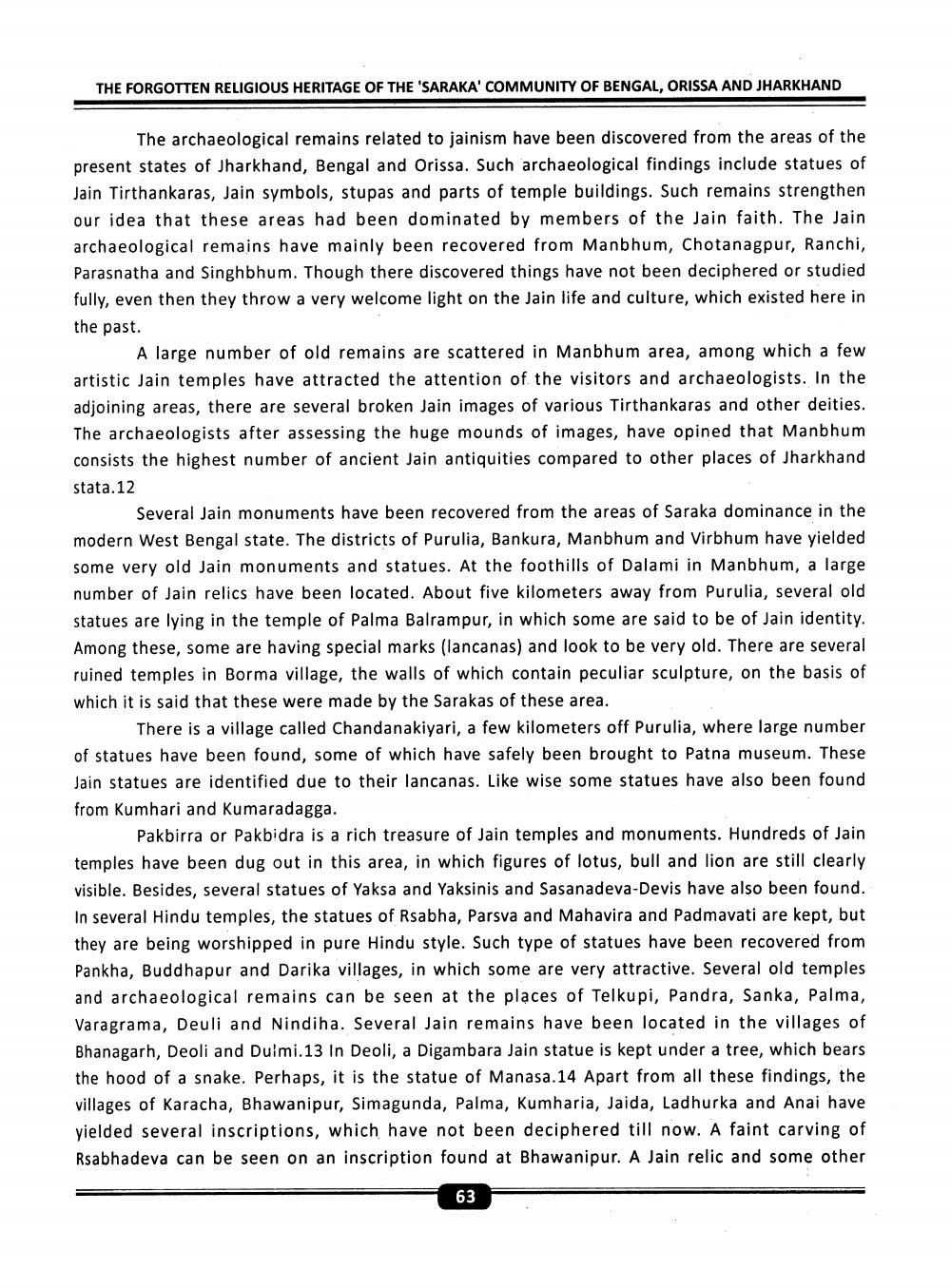________________
THE FORGOTTEN RELIGIOUS HERITAGE OF THE 'SARAKA' COMMUNITY OF BENGAL, ORISSA AND JHARKHAND
The archaeological remains related to jainism have been discovered from the areas of the present states of Jharkhand, Bengal and Orissa. Such archaeological findings include statues of Jain Tirthankaras, Jain symbols, stupas and parts of temple buildings. Such remains strengthen our idea that these areas had been dominated by members of the Jain faith. The Jain archaeological remains have mainly been recovered from Manbhum, Chotanagpur, Ranchi, Parasnatha and Singhbhum. Though there discovered things have not been deciphered or studied fully, even then they throw a very welcome light on the Jain life and culture, which existed here in the past.
A large number of old remains are scattered in Manbhum area, among which a few artistic Jain temples have attracted the attention of the visitors and archaeologists. In the adjoining areas, there are several broken Jain images of various Tirthankaras and other deities. The archaeologists after assessing the huge mounds of images, have opined that Manbhum consists the highest number of ancient Jain antiquities compared to other places of Jharkhand stata.12
Several Jain monuments have been recovered from the areas of Saraka dominance in the modern West Bengal state. The districts of Purulia, Bankura, Manbhum and Virbhum have yielded some very old Jain monuments and statues. At the foothills of Dalami in Manbhum, a large number of Jain relics have been located. About five kilometers away from Purulia, several old statues are lying in the temple of Palma Balrampur, in which some are said to be of Jain identity. Among these, some are having special marks (Iancanas) and look to be very old. There are several ruined temples in Borma village, the walls of which contain peculiar sculpture, on the basis of which it is said that these were made by the Sarakas of these area.
There is a village called Chandanakiyari, a few kilometers off Purulia, where large number of statues have been found, some of which have safely been brought to Patna museum. These Jain statues are identified due to their lancanas. Like wise some statues have also been found from Kumhari and Kumaradagga.
Pakbirra or Pakbidra is a rich treasure of Jain temples and monuments. Hundreds of Jain temples have been dug out in this area, in which figures of lotus, bull and lion are still clearly visible. Besides, several statues of Yaksa and Yaksinis and Sasanadeva-Devis have also been found. In several Hindu temples, the statues of Rsabha, Parsva and Mahavira and Padmavati are kept, but they are being worshipped in pure Hindu style. Such type of statues have been recovered from Pankha, Buddhapur and Darika villages, in which some are very attractive. Several old temples and archaeological remains can be seen at the places of Telkupi, Pandra, Sanka, Palma, Varagrama, Deuli and Nindiha. Several Jain remains have been located in the villages of Bhanagarh, Deoli and Dulmi.13 In Deoli, a Digambara Jain statue is kept under a tree, which bears the hood of a snake. Perhaps, it is the statue of Manasa. 14 Apart from all these findings, the villages of Karacha, Bhawanipur, Simagunda, Palma, Kumharia, Jaida, Ladhurka and Anai have yielded several inscriptions, which have not been deciphered till now. A faint carving of Rsabhadeva can be seen on an inscription found at Bhawanipur. A Jain relic and some other
63




